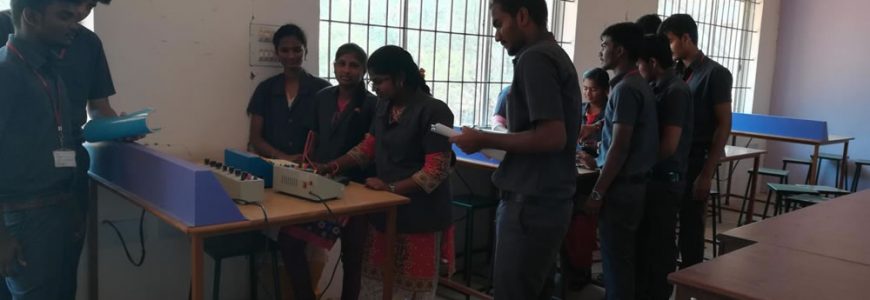
The EEE Department of Tamilnadu College of Engineering has consistently served as a genesis of Engineers of excellent calibre in the field of Electrical and Electronics Engineering for the past 9 years. As being one of the oldest self financing institutions in this region, students of EEE branch have become entrepreneurs and corporate heads – the vivid reason being the splendid knowledge that the students are imparted with all faculties. The department is endowed with dedicated team of faculty and state of the art laboratories with latest software. The department takes pride in students placed in core and multinational companies.
The department endeavours to produce confident professionals tuned to real time working environment. The department offers excellent academic environment with a team of highly qualified faculty members to inspire the students to develop their technical skills and inculcate the spirit of team work in them. The strength of the department lies in the highly motivated students who understand the dynamics of the industry and hone their skills accordingly.
The students of the department get placed in premier Indian and multinational IT companies and go on to attain prestigious positions.
To become a world class school and centre for excellence in Electrical and Electronics Engineering for higher level learning, research and consultancy.
Electrical and Electronics Engineering Graduates will be able to:
The software academic pursuits of the Electrical and Electronics Engineering (EEE) represent major accomplishments that we anticipate our graduates to achieve after three to five years of commencement.
Graduates of Electrical and Electronics Engineering will be
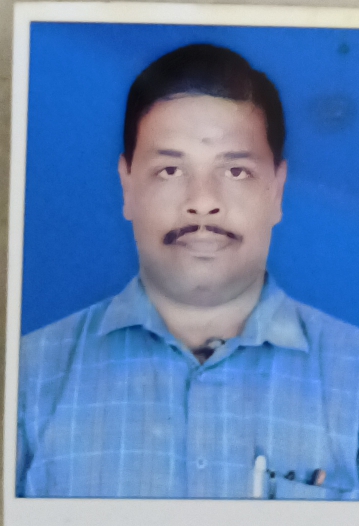
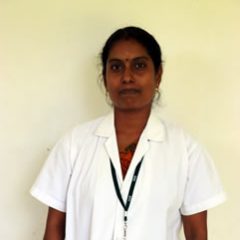
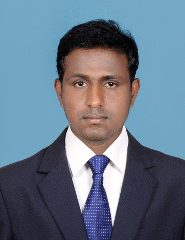
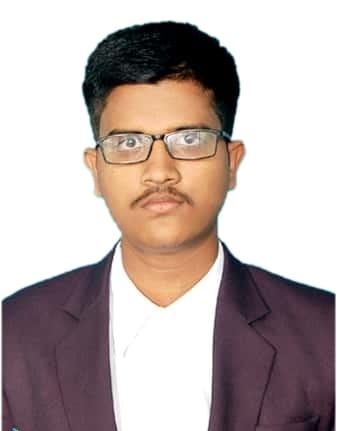
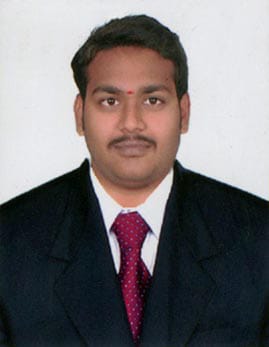
| S.NO | STUDENT NAME | NAME OF THE COLLEGE | NATURE OF THE EVENT | DATE (Academic Year) | PRIZE |
|---|---|---|---|---|---|
| 1 | PRATHAP RAJ S | TCE | PROJECT PRESENTATION | 2022-23 | FIRST PRIZE |
| 2 | PRATHAP RAJ S | KONGU ENGINEERING COLLEGE | PROJECT PRESENTATION | 2022-23 | FIRST PRIZE |
| 3 | A.MANISHA, M.PRIYADHARSHINI | SHREE SAKTHI ENGINEERING COLLEGE | PAPER PRESENTATION | 2022-23 | SECOND PRIZE |
| S.NO | STUDENT NAME | NAME OF THE COLLEGE | NATURE OF THE EVENT | DATE |
|---|---|---|---|---|
| 1 | Ms. PRIYANKA C | TCE | RANDEEP MEMORIAL AWARD BEST OUTGOING STUDENT OF EEE | 2014-18 |
| 2 | Ms. REVATHI S | TCE | RANDEEP MEMORIAL AWARD BEST OUTGOING STUDENT OF EEE | 2012-16 |
| 3 | Ms. HARISUDHA M | TCE | RANDEEP MEMORIAL AWARD BEST OUTGOING STUDENT OF EEE | 2013-17 |
| S.NO | NAME | COLLEGE | EVENT | DATE | PRIZE / PARTICIPATION |
|---|---|---|---|---|---|
| 1 | KARTHIK R | Sri Ramakrishna Engineering College | Project Presentation | 23/09/2017 | Participation |
| 2 | RANJITH A P | Dr.N G P Institute Of Technology | Project Presentation | 23/09/2017 | 2nd Prize |
| 3 | SUBASH M | Dr.N G P Institute Of Technology | Project Presentation | 23/09/2017 | 2nd Prize |
| 4 | RAJESH R | Dr.N G P Institute Of Technology | Project Presentation | 26/09/2017 | Participation |
| 5 | RANJITH A P | Jansons Institute Of Technology | Project Presentation | 26/09/2017 | Participation |
| 6 | KARTHIK R | Jansons Institute Of Technology | Project Presentation | 26/09/2017 | Participation |
| 7 | MANOJ A | Jansons Institute Of Technology | Project Presentation | 26/09/2017 | Participation |
| 8 | VIMAL S I | Jansons Institute Of Technology | Project Presentation | 23/09/2017 | 2nd Prize |
| 9 | SELVAM G | Dr.N G P Institute Of Technology | Project Presentation | 23/09/2017 | 2nd Prize |
| SL.NO | STUDENT NAME | EVENT & PROGRAM NAME | ORGANISER | DATE/ DURATION | PARTICIAPTION / PRIZE AWARD |
|---|---|---|---|---|---|
| 1 | Makesh M | Handball | Anna University | 15.9.17 to 16.9.17 | PARTICIPATION |
| 2 | Hariharan. S.V | Handball | Anna University | 15.9.17 to 16.9.17 | PARTICIPATION |
| 3 | Sabesh.S | Handball | Anna University | 15.9.17 to 16.9.17 | PARTICIPATION |
| 4 | Harikrishnan.R | Ball Badminton | KPR IET | 4.8.17 to 5.8.17 | PARTICIPATION |
| 5 | Keerthana L | Volley ball | RVS College | 23.8.17 to 24.8.17 | PARTICIPATION |
| 6 | Samundieswari.S | Ball Badminton | KPR IET | 4.8.17 to 5.8.17 | PARTICIPATION |
| 7 | Tamilselvi.M | Ball Badminton | KPR IET | 4.8.17 to 5.8.17 | PARTICIPATION |
| 8 | Shruthi.N | Ball Badminton | KPR IET | 4.8.17 to 5.8.17 | PARTICIPATION |
| 9 | Prakash.M | Kabadi | RVS College | 26.9.17 to 27.9.17 | PARTICIPATION |
| 10 | Vinoth.M | Kabadi | RVS College | 26.9.17 to 27.9.17 | PARTICIPATION |
| 11 | Ragu.K | Kabadi | RVS College | 26.9.17 to 27.9.17 | PARTICIPATION |
| 12 | Hariharan. S.V | Handball | KPR IET | 4.8.17 to 5.8.17 | PARTICIPATION |
| 13 | Makesh M | Handball | KPR IET | 4.8.17 to 5.8.17 | PARTICIPATION |
| 14 | Mahendran.P | Volley Ball | KIT | 15.9.17 to 16.9.17 | PARTICIPATION |
| 15 | Mugesh.M | Volley Ball | KIT | 15.9.17 to 16.9.17 | PARTICIPATION |
| 16 | Kabilathasan.B | Chess | Anna University | 21.9.17 | PARTICIPATION |
| 17 | Soundarya.G | Ball Badminton | CIT | 4.8.17 | PARTICIPATION |
| 18 | Priyanka.C | Ball Badminton | CIT | 4.8.17 | PARTICIPATION |
| 19 | Veeramani.P | Basket Ball | SRIT | 20.8.17 | PARTICIPATION |
| SL.NO | NAME OF THE STUDENT | YEAR & DEPT | ACADEMIC YEAR | NAME OF THE AWARD |
|---|---|---|---|---|
| 1 | Mr.K.SIVA | IV EEE | 2022-23 | RANDEEP MEMORIAL AWARD BEST OUTGOING STUDENT OF EEE |
| 2 | Mr.MOHAMMED RAFIQ.L | IV EEE | 2021-22 | RANDEEP MEMORIAL AWARD BEST OUTGOING STUDENT OF EEE |
| 3 | Mr.S.VISHWA | IV EEE | 2020-21 | RANDEEP MEMORIAL AWARD BEST OUTGOING STUDENT OF EEE |
| 4 | AJITHKUMAR K | IV EEE | 2019-20 | RANDEEP MEMORIAL AWARD BEST OUTGOING STUDENT OF EEE |
| 5 | Mr.MAKESH. M | IV EEE | 2018-19 | RANDEEP MEMORIAL AWARD BEST OUTGOING STUDENT OF EEE |
| S.No | Roll_No | Name | Batch No | Project Title |
| 1 | 17EE06 | KIRUBA K | Batch 1 | Mobile crowd sensing of parking space using geofnecing and activity recoginition |
| 2 | 17EE12 | NIRMAL RAJ M | ||
| 3 | 17EE13 | OVIYA C | ||
| 4 | 17EE14 | RAHUL P | ||
| 5 | 17EE16 | VASANTHKUMAR S | ||
| 6 | 17EE10 | MANIMEGALAI M | Batch 2 | Brake Failure Indicator |
| 7 | 17EE11 | MONISHA S | ||
| 8 | 17EE15 | RAMPRIYA R | ||
| 9 | 17EE201 | JENIFERRAJ .L | ||
| 10 | 17EE02 | AJITHKUMAR B | Batch 3 | GSM Based Home Automation using Aurdino |
| 11 | 17EE04 | JAYAPRAKASH G | ||
| 12 | 17EE05 | JEEVA R | ||
| 13 | 17EE08 | MAHESHWARAN M | ||
| 14 | 17EE09 | MANGESHWARAN V | ||
| 15 | 17EE205 | VISWANATH .A.P | ||
| 16 | 17EE01 | AARTHI K | Batch 4 | SMART-Water monitoring system |
| 17 | 17EE07 | KRISHNAKUMAR A | ||
| 18 | 17EE17 | KALAIVANI C | ||
| 19 | 17EE203 | SREEJITH.S | ||
| 20 | 17EE204 | SUNDARA MOORTHY.R | ||
| 21 | 17EE18 | LAVANYA L | ||
| SL.NO | STAFF NAME | EVENT & PROGRAM NAME | DATE/ DURATION | REMARKS |
|---|---|---|---|---|
| 1 | Dr. G. Saravana Kumar | Phd Guidance | 12/1/2017 | A research scholor had completed Phd under his Guidance ad have a Guidance experience of 10 years |
| 2 | Dr. G. Saravana Kumar | Reviewer | 12/1/2017 | Reviewer for four international journals |
| 3 | Dr. G. Saravana Kumar | Project Guidance | 12/1/2017 | Guided projects for International Association for the exchange of students for Technical experience, students from different countries |
| 4 | Dr. G. Saravana Kumar | membership | 12/1/2017 | Had a lifetime membership with Indian society of technical education, Instrumentation society of India , System society of India, International Association of Engineers , IEEE. |
| 5 | S M Devasugan | Enterpreneueship Awareness camp | 08/08/2017-10/08/2017 | Got funding from Entrepreneurship Development Institute, Ahmadabad for conducting “Entrepreneurship Awareness Camp” two years consequently. |
| 6 | S M Devasugan | National Conference on Recent Trends in Electrical Science | 14/03/2018 | organized conference for the last three years consequently |
| S.NO. | FACULTY NAME | TITLE OF THE PAPER | JOURNAL NAME | N/I | VOLUME |
| 1 | Dr.G.Saravanakumar | Design And Modeling Of Improved Controller Using Dc Source Fed Permanent Magnet Synchronous Motor Drive With Enhanced Dc-Dc Converter By Reducing Vibrations For Industrial Applications | Journal Of Vibroenginee Ring | February 2019, Volume 21, Issue 1 | |
| Design And Implementation Of Solar Power Fed Permanent Magnet Synchronous Motor With Improved Dc-Dc Converter And Power Quality Improvement Using Shunt Active Filter For Reducing Vibration In Drive For Industrial Applications | Journal Of Vibroenginee Ring | March 2019, Volume 21, Issue 2 | |||
| Tuning of Two Degree of Freedom PID Controller for Integral process with longer delay Time Delay using auto tuning Hybrid Controller | International Journal of Automation and Control | I | ISSN: 17407524 | ||
| Power Quality Improvement for Grid Connected Renewable Energy System Using FLC | International Journal of Engineering Trends and Technology | I | Volume 53 | ||
| Harmonic Suppression System Using SRF and SIP Control Strategies | International Journal of Innovative Trends in Engineering | I | Volume 35 | ||
| Wireless Sensor Network Implemented in EB Board Using IOT | International Journal Of Innovative Science And Applied Engineering Research | I | Volume 13 | ||
| performance of a three phase power system employing shape using various control algorithms | International Journal of Printing, Packing and Allied Sciences | I | Vol. 4 | ||
| Modified Optimum Dominant Pole placement method(MODPP) for Integral process with large Dead time For Two Degree of Freedom Controllers | International Journal of Recent Trend in Engineering and Research | I | ISSN (Online) 2455-1457Volume 2 | ||
| Regenerative Braking in Electric Vehicle Using By-Wire Braking System | CIIT | I | Vol 11 No 3
Mar 2019 |
||
| Channel Modelling and Performance Characterization of Underwater Visible Light Communication | CIIT | I | Vol 11 No 3
Mar 2019 |
||
| 2 | G.Ramya | Improved Energy Utilization within Smart Grid | CIIT Journal- Data Mining and Knowledge Engineering | N | Vol 10 |
| An Automatic Plant Irrigation and Fertile Control for Agricultural Farm | International Journal of Programmable Device Circuits and Systems | I | Vol 12, No 02, February 2020. | ||
| 3 | S.M.Devasugan | An Automatic Plant Irrigation and Fertile Control for Agricultural Farm | International Journal of Programmable Device Circuits and Systems | I | Vol 12, No 02, February 2020. |
| Automatic Solar Panel Cleaning And Tracking System | CIIT | I | Vol 11 No 3
Mar 2019 |
||
| 4 | M.Pradeep Kumar | Iot Based Smart Monitoring And Management System | CIIT | Vol 11 No 3
Mar 2019 |
|
| 4 | S. Vivek | Implementation Of Optimised Power Sharing During Heavy Demands Energy Recording Cum Control System | Ciit Journal- Networking And Communication Engineering | N | Vol 10 |
| Transformer Less Grid Connected Inverter With Active And Reactive Power Control In Distributed Generation System | CIIT | Vol 11 No 3
Mar 2019 |
|||
| 5 | M.V.Ramya | Automated Map Generating And Ranging Robot | CIIT | Vol 11 No 3
Mar 2019 |
| Sl.No | NAME OF THE FACULTY | TITLE | YEAR | NAME OF THE JOURNAL | ISSN NO |
| 1 | G.Ramya and M.Pradeepkumar | The Design and Implementation of a Shunt Active Power Line Conditioner Using Some Innovative Control Strategies | 2022-2023 | Journal of Xidian University | 2ISSN No:1001-2400 |
| 2 | G.Ramya | Power Quality Concerns due to Power System Improvements with Renewable Energy Sources and its Remedies | 2022-2023 | Journal of Trends in Computer Science and Smart Technology | ISSN 2582-4104 |
| 3 | G.Ramya and B.Christyjuliet | Design and Implementation of Continuous Inductive Wireless Power Transfer System for Electric Vehicle | 2022-2023 | CiiT International Journal of Wireless Communication | ISSN 0974-9756 |
| 4 | M.Pradeep Kumar | Grid frequency regulation by hybrid system using energy storage system | 2019-2020 | INDIAN JOURNAL OF POWER AND RIVER VALLEY DEVELOPMENT | 0019-5537 |
| Sl.No | ACADEMIC YEAR | NAME OF THE PRINCIPAL INVESTIGATOR/CO-INVESTIGATOR | NAME OF THE FUNDING AGENCY | FUNDS PROVIDED (INR IN LAKHS) |
| 3 | 2020 - 2021 | Dr. G. Saravana Kumar | AICTE, New Delhi | 4,23,333.0 |
| Dr.R.Siva Kumar | TNSCST, TAMILNADU | 20,000.0 | ||
| 2 | 2019 - 2020 | Dr. G. Saravana Kumar | ENTREPRENEURSHIP DEVELOPMENT INSTITUTE OF INDIA, AHMEDHABAD | 20,000.0 |
| DR.K.KRISHNESHWARI | AICTE, New Delhi | 1,27,333.0 | ||
| 1 | 2018 - 2019 | Dr.R.Siva Kumar | AICTE, New Delhi | 20,04,152.0 |
| Dr.R.Siva Kumar | AICTE, New Delhi | 2,01,657.0 | ||
| Dr.G.Saravana Kumar | ENTREPRENEURSHIP DEVELOPMENT INSTITUTE OF INDIA, AHMEDHABAD | 20,000.0 | ||
| Dr.G.Saravana Kumar | TNSCST, TAMILNADU | 20,000.0 | ||
| Dr.G.Saravana Kumar | AICTE, New Delhi | 3,26,666.0 |
| Sl.No | Scheme Name | Principal Coordinator | Title | Status | Academic Year | Grant Amount |
| 1 | PRERANA – Scheme For Preparing SC/ST Students For Higher Education (AICTE) | Dr. G. Saravana Kumar | GATE Coaching for SC/ST students to Pursue Higher Education | GRANT RECEIVED | 2019-20 | 10 Lakhs |
| 2 | DST-NIMAT | Dr. G. Saravana Kumar | Entrepreneurship Awareness Camp | GRANT RECEIVED | 2019-20 | 40,000 |
| 3 | DST-NIMAT | Dr. G. Saravana Kumar | Entrepreneurship Awareness Camp | GRANT RECEIVED | 2018-19 | 20,000 |
| 4 | DST-NIMAT | Dr. G. Saravana Kumar | Entrepreneurship Awareness Camp | GRANT RECEIVED | 2017-18 | 20,000 |
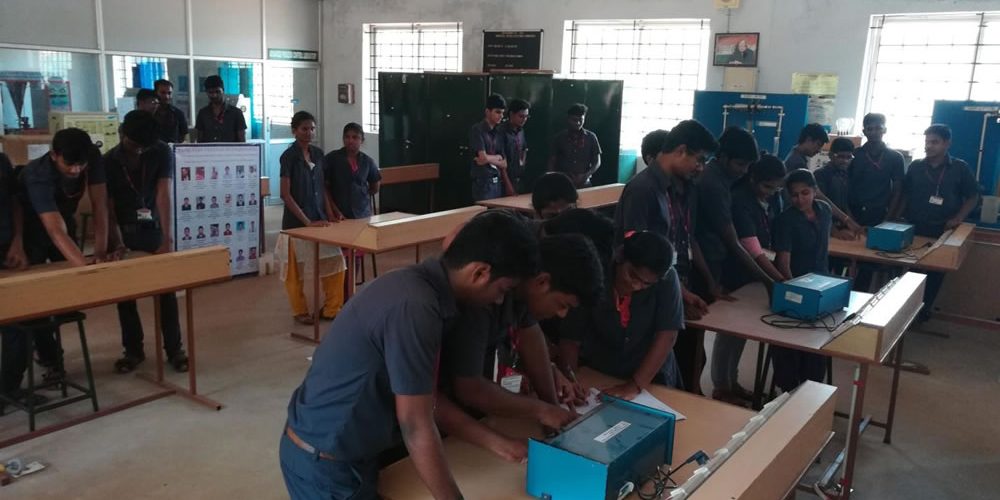
Modern industries have complex control and instrumentation. This laboratory helps to know about the process control and instrumentation which is carried out in industries. Nowadays, industries are fully automated and controlled automatically. The machines are being analysed and recorded by using instrumentation and controlled.
| TOTAL COST OF THE LAB: | 1, 60,986 Rupees |
| TOTAL AREA OF THE LAB: | 100 Sq.M |
| STUDENT DETAILS (YEAR/SEM): | III YEAR/ V SEM |
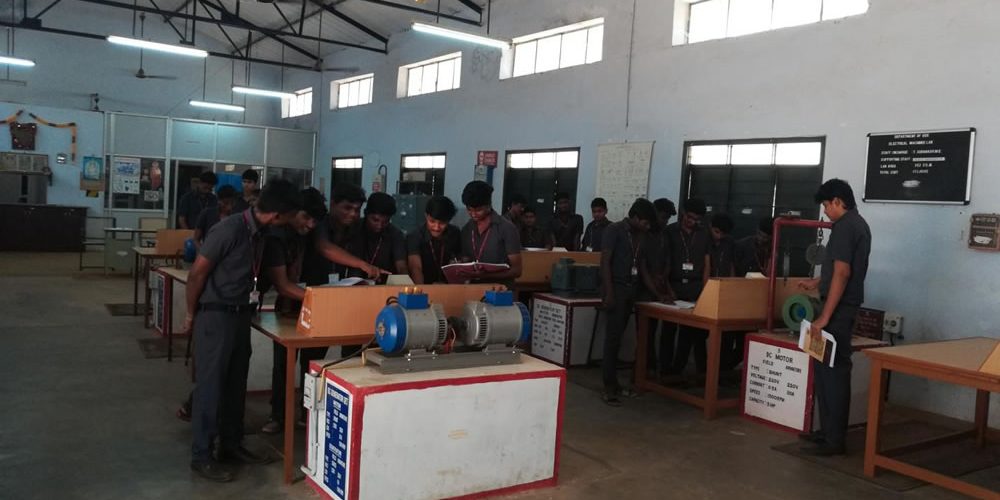
This lab consists of experiments involving single and three phase transformers, induction machines, synchronous machines and DC machines. This laboratory helps the students by understanding the basic theory and operation of electrical machines, how electrical machines fit into the larger context of power systems. The students can understand using procedures and analysis techniques to perform and describe electromagnetic and electromechanical tests on electrical machines.
| TOTAL COST OF THE LAB: | 10,49,960 Rupees |
| TOTAL AREA OF THE LAB: | 352 Sq.M |
| STUDENT DETAILS (YEAR/SEM): | II YEAR EEE / IV SEM, II YEAR ECE / IV SEM, II YEAR ICE / III SEM, III YEAR EEE / V SEM. |
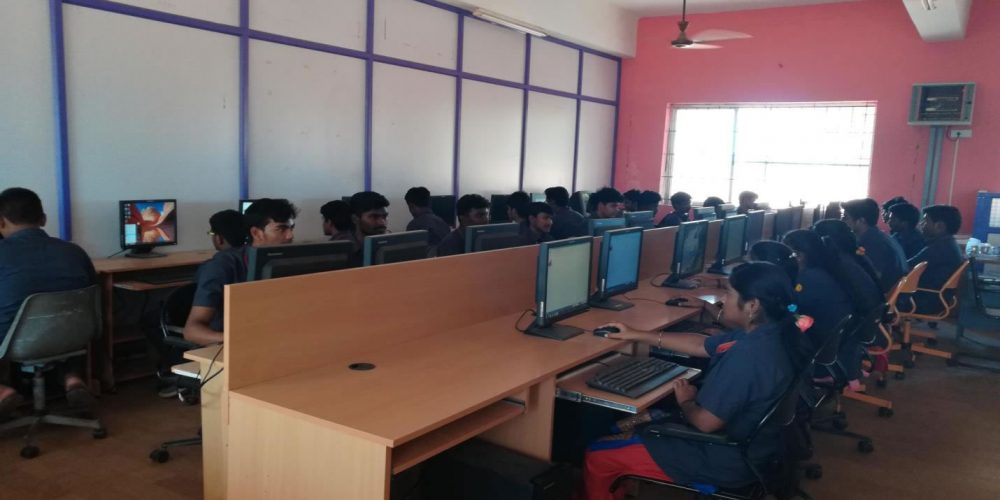
The Power Systems Simulation Laboratory (PSSL) research areas include modeling, simulation, and optimization of electric power systems (reliability); and planning, protection, automation, control and power quality. The lab is equipped with power system simulation software and hardware simulators such as power system micro-models fitted with protective relays, remote terminal units (RTUs), and supervisory control and data acquisition (SCADA).
| TOTAL COST OF THE LAB: | 1,39,587 Rupees |
| TOTAL AREA OF THE LAB: | 100 Sq.M |
| STUDENT DETAILS (YEAR/SEM): | IV YEAR/ VII SEM |
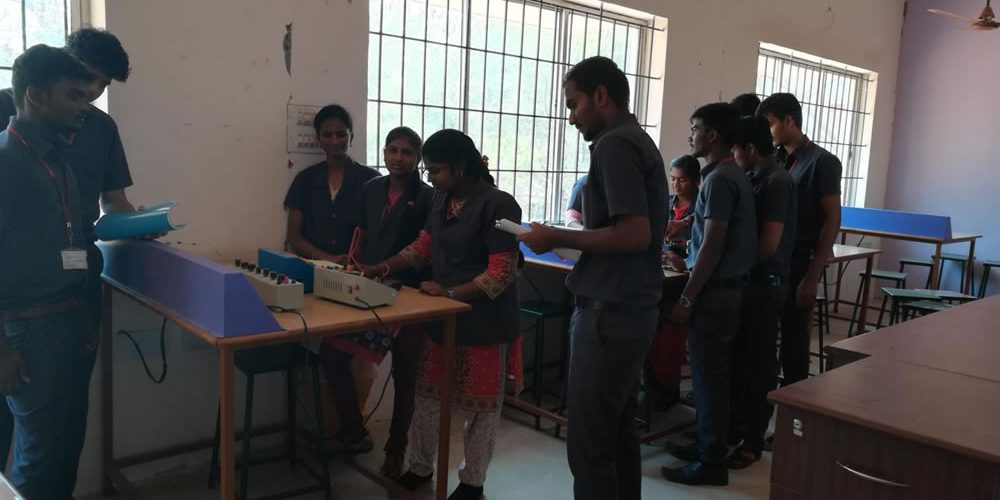
In the Electrical Circuit Lab students can create their own electrical circuits and do measurements on it. In the circuits the students can use resistors, light bulbs, switches, capacitors and coils. The circuits can be powered by a AC/DC power supply or batteries. There is an ammeter, voltmeter, wattmeter and an ohmmeter. There is also a version of the Electrical Circuit Lab in which data can be collected. Students can analyze the collected data by creating graphs of the data and use the graphs in the conclusion tool.
| TOTAL COST OF THE LAB: | 4, 63,520Rupees |
| TOTAL AREA OF THE LAB: | 68 Sq.M |
| STUDENT DETAILS (YEAR/SEM): | I YEAR/ II SEM |
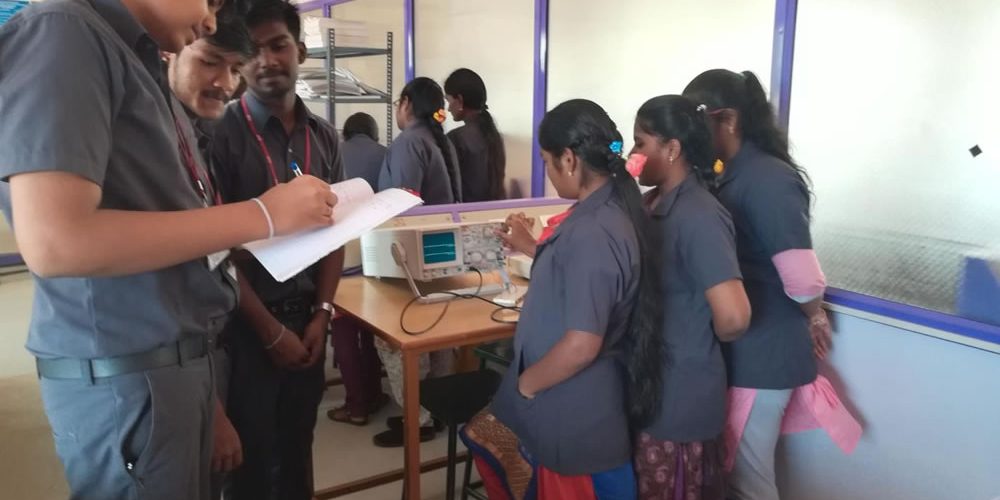
This is the laboratory for Electronic Devices and Circuits. Equipment sets are available for the students to perform basic experiments in electronics area. The lab also is where the senior projects in the Electronics area are built and tested. Several PC’s are also available in the lab, for students and Faculty use, particularly in the circuit analysis, device modelling and VLSI areas.
| TOTAL COST OF THE LAB: | 1, 56,180Rupees |
| TOTAL AREA OF THE LAB: | 71.2 Sq.M |
| STUDENT DETAILS (YEAR/SEM): | II YEAR/ III SEM |
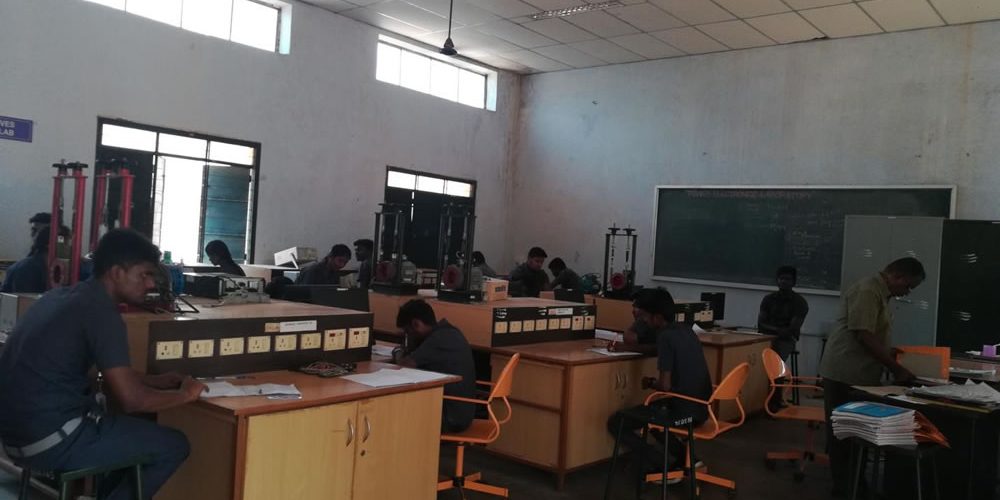
The laboratory course provides instruction in general lab practices, measurement methods, and with the design and operation of several common circuits relevant to the field of power electronics. It also provides experience with common components such as motors, batteries, magnetic devices, and power semiconductors.
| TOTAL COST OF THE LAB: | 6, 64,740Rupees |
| TOTAL AREA OF THE LAB: | 68 Sq.M |
| STUDENT DETAILS (YEAR/SEM): | III YEAR/ VI SEM |
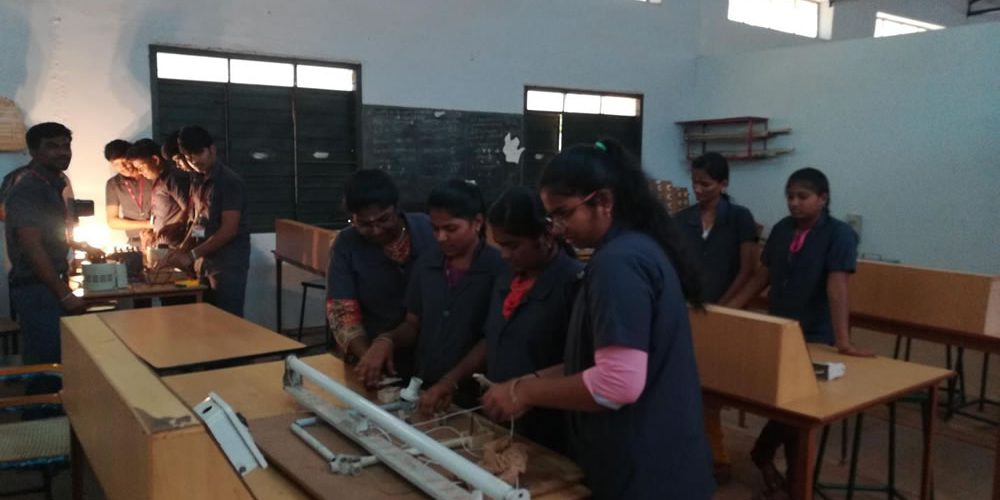
Engineering Practices Lab Manual covers all the basic engineering lab practices in the Civil, Mechanical, Electrical and Electronics areas. This lab is so helpful for the students by understanding the basic knowledge on other engineering departments.
| TOTAL COST OF THE LAB: | 17,535 Rupees |
| TOTAL AREA OF THE LAB: | 352 Sq.M |
| STUDENT DETAILS (YEAR/SEM): | I YEAR/ I SEM |
In addition to the Central Library, a well-equipped departmental library is functioning in the department catering to the needs of the faculty and students with a total book capacity of 215. To quench the thirst for knowledge of the pupils, the college have three storied a spacious and well – stocked library. The department library has good collection of books journals of national and international. All modern resources such as cd-rom, online database, journals, audio- visual for NPTEL video and web courses are also available. It uses the state-of-the-art technology in its function and services.
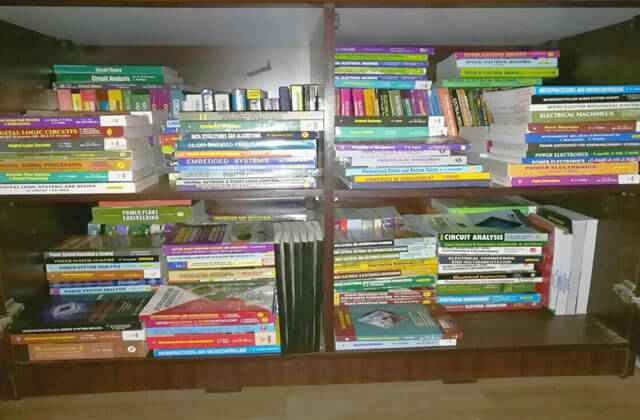
| S.NO | DATE | EVENT | TOPIC | CONDUCTED |
|---|---|---|---|---|
| 1 | 06.06.2022 | Seminar | Seminar on startup funds and banking processes | Mr.S.Jebaseelan Samraj Senior Manager, KLM Axiva Finvest, Avinashi Branch, Coimbatore. |
| 2 | 30.09.2020 | Seminar | ENTREPRENEURSHIP AWARENESS CAMP | Mr.A.Asokan, Director, Canara Bank-RSETI |
| 3 | 22.11.2021 | Seminar | Seminar on “How to write to research paper?” | Dr.Sivaraj, HOD/EEE RVSTC, Coimbatore |
| 4 | 27-07-18 | ENIAC’18 | Motivational and recent technologies | V.sathiyaraj B.E,MIT(Aus), Chairman of sathya construction. |
| 5 | 03-04-18 | Guest Lecture | Role of Ethical Hacking in defence | Venkatesh – President & CEO (Tamilnadu Cyber Army) Indian Cyber Army |
| 6 | 24-03-18 | Guest Lecture | Gate Exam- Vital Importance And Benefits | GATE FORUM |
| 7 | 23-03-18 | Motivational Speech | Personality Development & Industry Requirements | Mr.Mathew Kuruvilla, Chief Marketing Officer- Excellone Technologies |
| 8 | 14-02-18 | Seminar | Digital Transformation | Mr.Arunkumar Manager- NIIT Chennai – Mr.Sree kanth sugumaran, Manager, Digitek Business Solutions |
| 9 | 01-02-18 | Protocall-18 | Developing the entrepreneurial abilities & Soft skills | Mr.C.S.Chandrasekar, Founder & Chief Technology Officer, ESP infoway PVT.Ltd |
| 10 | 3-10-17 | Seminar | Cyber security and soft skills training | Mr.Siva prakash B.E, M.S(U.K). Technology Associate,Morgon Stanley, Glassgow(U.K) |
| 11 | 24-8-17 | TECHNAK-17 | Recent trends & technologies in software industries | Mr.Balanagesh Srinivasan Project Manager- Robert Bosch |
| 12 | 21.08.2017 | Training Program | Two Days Workshop on Python Programming | Accent Techno Solutions |
| 13 | 11.08.2017 &12.08.2017 | Workshop | Two Days Workshop on Python Programming | Accent Techno Solutions |
| S.NO | Event | Company | Title | Date | Staff |
|---|---|---|---|---|---|
| 1 | Seminar | PROLIFIC SYSTEMS & TECHNOLOGIES Pvt Ltd, COIMBTAORE | INDUSTRIAL AUTOMATION & ITS APPLICATION | 11/07/2017 | Mr K Senthil Kumar |
| 2 | Seminar | GATE FORUM, COIMBATORE | AWARENESS ABOUT GATE EXAMINATION | 18/07/2017 | Mrs.G Ramya |
| 3 | Seminar | SWITCH GEAR TRAINING & RECRUITMENT SOLUTIONS, COIMBATORE | LOW VOLTAGE & HIGH VOLTEGE SWITCH GEAR | 27/07/2017 | Mrs.G Ramya |
| 4 | Workshop | WABCO TECHNOLOGIES | EMBEDDED SYSTEMS | 01/08/2017 | Mr. S M Devasugan |
| 5 | Seminar | INFOSYS Ltd, TRIVANDRUM INDUSTRY ORIENTED | CARRER DEVELOPMENT | 07/08/2017 | Mr Bala Kumar N |
| 6 | Seminar | ENTERPRENEURSHIP AWARENESS CAMP | ENTERPRENE-URSHIP | 08/08/2017-10/08/2017 | Mr. S M Devasugan |
| 7 | Seminar | 3W ENGINEERING SERVICES, COIMBATORE | INDUSTRY ORIENTED DEVELOPMENT PROGRAM ON ELECTRICAL WIRING AND DESIGNING | 17/08/2017 | Mr Senthil Kumar K Mr Pradeep Kumar M |
| 8 | Inuagration | ASSOCIATION INUAGRATION | TNEB METEUR POWER PLANT | 30/09/2017 | Mr Bala Kumar N |
| 9 | Seminar | LIVE WIRE SOLUTIONS, COIMBATORE | ROBOTICS AND EMBEDDED SYSTEMS | 14/09/2017 | Mr Senthil Kumar K Mr Pradeep Kumar M |
| 10 | Conference | National conference | Recent trends in Electrical Science | 14/03/2018 | Mr s m Devasugan |
| S.NO | NAME OF THE PROGRM | YEAR | DATE | DURATION (HOURS) | RESOURSE PERSON |
|---|---|---|---|---|---|
| 1 | VACEE01 & ELECTRIC VEHICLE AND BATTERY MANAGEMENT SYSTEM | II, III, IV YEAR | 09.01.2023 to 18.02.2023 | 45 hours | Mr.M.PRADEEP KUMAR |
| 2 | VACEE01 & INDUSTRIAL PLANT AUTOMATION | II, III, IV YEAR | 05.05.2022 to 07.06.2022 | 45 hours | Mrs. G.RAMYA |
| 3 | VACEE01 & MOBILE APP DEVELOPMENT | II, III, IV YEAR | 24/11/2020 to 28/12/2020 | 30 hours | MP.SAKTHIVEL |
| 4 | VACEE01 & MOBILE APP DEVELOPMENT | II YEAR | 30/01/2020 to 27/02/2020 | 30 hours | P.SAKTHIVEL |
| 5 | VACEE02 & MOBILE APP DEVELOPMENT | IV YEAR | 21/01/2019 to 21/02/2019 | 30 hours | Mr. S.M.DEVASUGAN |
| 6 | VACEE01 & INDUSTRIAL PLANT AUTOMATION | IV YEAR | 21/01/2019 to 21/02/2019 | 48 hours | Mrs.G.RAMYA |
| ACADEMIC YEAR 2022-2023 | ||||
| REGULATION 2021 & 2017 | ||||
| SEM | Course Code | Course Name | Course Outcome | |
| SEM1 | HS3151 | Professional English - I | CO1 | Understand and produce simple sentences related to everyday situations. |
| CO2 | Apply appropriate transitions in the oral and written presentation. | |||
| CO3 | Analyze grammatical and lexical elements in relation to sentence function and meaning. | |||
| CO4 | Evaluate independent learning strategies and study skills. | |||
| CO5 | Develop and create own ideas to enrich the communication skills. | |||
| SEM1 | MA3151 | Matrices and Calculus | CO1 | Understanding the concept of limit, continuity and detrivatives of a function, Jacobian, Taylor’s series, Lagrange’s multipliers Definite and Indefinite integrals, Improper integrals, multiple integrals and System of simultaneous linear differential equations with constant coefficients |
| CO2 | Apply the rules to Solving the problems in differentiation ,finding Maxima and Minima of functions of one and two variables, calculate partial differentiation of implicit functions and applying integration techniques to evaluate the ordinary and multiple integrals and integration of irrational functions | |||
| CO3 | To Acquires skills to analyse Euler’s theorem, solving integrals using various techniques of integration, Determining convergence/divergence of improper integrals differential equations by method of variation of parameter, obtaining the solution to the undetermined coefficients | |||
| CO4 | Evaluation of simultaneous differential equations, Taylor’s series, maxima and minima, Ordinary and multiple integrals using polar co-ordinates | |||
| CO5 | To create and combining different techniques to obtain the solutions to the real life problems involved in differentiation, partial differential equations, integration, Taylor’s series | |||
| SEM1 | PH3151 | Engineering Physics | CO1 | To understand the Stress-strain ,Oscillatory motion forced and damped oscillations thermal conduction, convection and radiation Black body radiation Compton effect |
| CO2 | To apply the thermal insulation like heat exchangers, refrigerators, ovens and solar water heaters. | |||
| CO3 | To analyze the coordination number and packing factor for SC, BCC, FCC, HCP and diamond structures | |||
| CO4 | To evaluate the numerical aperture and acceptance angle | |||
| CO5 | To demonstrate the torsion pendulum cantilever uniform and non-uniform bending | |||
| SEM1 | CY3151 | Engineering Chemistry | CO1 | Applying the advanced modern scientific and engineering techniques as well as tools to assess the removal of hardness, zeolite process, applications of adsorption on pollution abatement, minimize the utilization of catalysts, formation of steel, urban problems related to energy and role of secondary & fuel batteries for our future. |
| CO2 | Analyze of the structure and function of EDTA methods, ion exchange resin, Langmuir‘s adsorption isotherm in contact theory & kinetics of surface unimolecular reactions, enzyme catalysis, - thermal analysis and cooling curves of phase rules, manufacture of metallurgical coke, flue gas analysis of exhaust gases, controlled nuclear fission & nuclear fusion reactions. | |||
| CO3 | Evaluation of internal and external treatment process, adsorption of solute from solutions, catalytic poisoning and promoters in synthesis process, Pattinson process, synthetic petrol by Bergius process and controlled breeder reactor. | |||
| CO4 | Describing real life application of modern scientific tools for solving problems related to desalination of brackish water, catalytic convertor, Nichrome & stainless steel manufacturing, petroleum refining, solar energy conversion and future renewable energy sectors. | |||
| SEM1 | GE3151 | Problem Solving and Python Programming | CO1 | Examine python syntax and semantics and be fluent in the use of python flow control and functions |
| CO2 | Demonstrate proficiency in handling Threads, File and Exceptions | |||
| CO3 | Analyze python program using core data structure like Lists, dictionaries and use regular Expressions. | |||
| CO4 | Interpret the concepts of GUI and WEB programming as used in Python. | |||
| CO5 | Implement exemplary application related to Database Programming with ORM in python. | |||
| SEM1 | GE3171 | Problem Solving and Python Programming Laboratory | CO1 | Student should be able to understand the basic concepts scripting and the contributions of scripting language |
| CO2 | Examine the core data structures like lists, dictionaries, tuples and sets in Python to store, process and sort the data. | |||
| CO3 | Identify the external modules and import specific methods form them | |||
| CO4 | Demonstrate proficiency in handling Strings and File Systems. | |||
| CO5 | Ability to explore python especially the object oriented concepts, and the built in objects of Python | |||
| SEM1 | BS3171 | `Physics and Chemistry Laboratory | CO1 | To understand and also remember the basic concepts of wastewater generation, collection system, wastewater quality and standards. Also demonstrate the experimental skills. |
| CO2 | To apply the basic principles for wastewater, conductometric, pH and potentiometric methods for the determination of the concentration as well as amount of the compounds present in the sample. | |||
| CO3 | To analyses and interpret the data for quantitative estimation of the materials present in the given samples. | |||
| CO4 | Design and Interpret field data in case of actual field problems related to wastewater & contaminations sources and also prepare the suitable models of real life applications using RO, zeolite & removal of materials by adsorbent. | |||
| SEM2 | HS3251 | Professional English - II | CO1 | Able to understand the listening exercises to enhance practical knowledge in communicative English |
| CO2 | To apply and enrich knowledge in the literacy skills. | |||
| CO3 | Analyzing to communicate and write appropriately in varied formal and informal contexts. | |||
| CO4 | Ability to evaluate the issues and find the rudiments of the problem individually and as a group | |||
| CO5 | To design their abilities as creative thinkers, readers and writers | |||
| SEM2 | MA3251 |
Statistics and Numerical
Methods |
CO1 | Remembering the concept of Eigen values and Eigen vectors, Scalar potential, gradient, divergence, directional derivatives, curl , analytic functions Understanding the concept of Cayley-Hamilton Theorem, Angle between two surfaces, work done by force and independent of the path of the curve, Necessary and sufficient condition for analyticity and Cauchy’s integral theorem and formula and Transform of elementary, unit step and unit impulse function Laplace Transform and inverse transform of simple functions, |
| CO2 | Applying Cayley-Hamilton Theorem, transformations to diagonalize similar and symmetric matrices properties of Eigen values and Eigen vectors, canonical form for Quadratic form by orthogonal reduction, line, surface and volume integra,Solenoidal and irrottational vectors, Harmonic conjugates, bilinear transformations ,conformal mapping, and complex integration, real integral using residue theorem, transform of periodic function | |||
| CO3 | Analyze Orthogonal vectors, Nature of the Quadratic form, Green, Stokes and Gauss divergence theorems, Properties of analytic functions, Taylor and Laurent series, Singularities, residue theorem and contour integration, Inverse Laplace transform, solution of linear second order differential equations with constant coefficients Shifting, initial and final value and convolution theorem | |||
| CO4 | Evaluation of circuit using atrices, curve length, Area and volume of irregular shapes using line, surface and volume integral , time average power flow density using Vectors graphical image of approximation with Taylor series, application of Laplace transform in cryptography , solution of linear second order differential equations with constant coefficients using real time applications | |||
| CO5 | Describing real life application of Eigen values and vectors in image processing, and cryptography vector concepts, image processing using bilinear transformations , distinguishing singularities and poles, Laplace transform and convolution theorem | |||
| SEM2 | PH3202 | Physics for electronics engineering | CO1 | To make the students to understand the basics of dielectric materials and insulation. |
| CO2 | To understand the electrical properties of materials including free electron theory, applications of quantum mechanics and magnetic materials | |||
| CO3 | To instil knowledge on physics of semiconductors, determination of charge carriers and device applications | |||
| CO4 |
To establish a sound grasp of
knowledge on different optical properties of materials, optical displays and application |
|||
| CO5 | To inculcate an idea of significance of nano structures, quantum confinement and ensuing nano device applications. | |||
| SEM2 | BE3255 | BASIC CIVIL AND MECHANICAL ENGINEERING | CO1 | Understanding profession of Civil and Mechanical engineering. |
| CO2 | CO2: Summarise the planning of building, infrastructure and working of Machineries. | |||
| CO3 | CO3: Apply the knowledge gained in respective discipline | |||
| CO4 | CO4: Illustrate the ideas of Civil and Mechanical Engineering applications. | |||
| CO5 | CO5: Appraise the material, Structures, machines and energy. | |||
| SEM2 | GE3251 | Engineering Graphics | CO1 | Ability to understand the basics Projection of Points , Planes, Solids, Section of Solids , Isometric Projection and Development surfaces for simple solids. |
| CO2 |
Ability to Apply the basics
Projection of Points , Planes, Solids, Section of Solids ,
Isometric Projection and Development surfaces for simple solids. |
|||
| CO3 |
Able to analyze the basics
Projection of Points , Planes, Solids, Section of Solids ,
Isometric Projection and Development surfaces for simple solids. |
|||
| CO4 | Able to Explore Simple Solids generated by one modeling tool. | |||
| CO5 | Ability to design simple Solids generated by one modeling tool. | |||
| SEM2 | GE3271 | Engineering Practices Laboratory | CO1 | Ability to apply basic machining operations, welding, plumbing, sheet metal operations in order to produce the desired work output. |
| CO2 | Ability to analyse outputs of machining operations like turning, facing, milling and plumbing works, sheet metal operations, soldering and home electrical works. | |||
| CO3 | Ability to conduct the experiments as individual or team by using CNC and CAD/CAM. | |||
| CO4 | Ability to make an effective report based on experiments | |||
| SEM2 | EE3271 | Electric circuit laboratory | CO1 | Use simulation and experimental methods to verify the fundamental electrical laws for the given DC/AC circuit (Ex 1) |
| CO2 | Use simulation and experimental methods to verify the various electrical theorems (Superposition, Thevenin , Norton and maximum power transfer) for the given DC/AC circuit (Ex 2-5) | |||
| CO3 | Analyze transient behavior of the given RL/RC/RLC circuit using simulation and experimental methods (Ex 6) | |||
| CO4 |
Analyze frequency response of
the given series and parallel RLC circuit using simulation and experimentation methods (Ex 7-8) |
|||
| SEM2 | EE3251 | ELECTRIC CIRCUIT ANALYSIS | CO1 | Explain circuit’s behavior using circuit laws. |
| CO2 | CO2: Apply mesh analysis/ nodal analysis / network theorems to determine behavior of the given DC and AC circuit | |||
| CO3 | CO3: Compute the transient response of first order and second order systems to step and sinusoidal INPUT | |||
| CO4 | Compute power, line/ phase voltage and currents of the given three phase circuit | |||
| CO5 | Explain the frequency response of series and parallel RLC circuits AND magnetically coupled circuits | |||
| SEM2 | GE3272 | COMMUNICATION LABORATORY | CO1 | Speak effectively in group discussions held in a formal/semi formal contexts |
| CO2 | :Discuss, analyse and present concepts and problems from various perspectives to arrive at suitable solutions | |||
| CO3 | Write emails, letters and effective job applications | |||
| CO4 | Write critical reports to convey data and information with clarity and precision | |||
| CO5 | :Give appropriate instructions and recommendations for safe execution of tasks | |||
| SEM2 | GE3252 | Tamils technology | CO1 | To know about the technologies during the sangam age |
| CO2 | To know about the design and construction technology during he sangam age To know about the develpoment of at Tamilnadu during the British period | |||
| CO3 | To understand about the uses of the metals of Gold ,Copper,Gems during the sangam age To know the evidance described in silappathigaram | |||
| CO4 | To know about the Agriculture amd irrigation technology during the sangam age | |||
| CO5 | To know about th development of scientific Tamil &Tamil Computing | |||
| SEM 3 | MA3303 | PROBABILITY AND COMPLEX FUNCTIONS | CO1 | Understand the fundamental knowledge of the concepts of probability and have knowledge of standard distributions which can describe real life phenomenon |
| CO2 | Understand the basic concepts of one and two dimensional random variables and apply in engineering applications. | |||
| CO3 | To develop an understanding of the standard techniques of complex variable theory in particular analytic function and its mapping property | |||
| CO4 | To familiarize the students with complex integration techniques and contour integration techniques which can be used in real integrals | |||
| CO5 | To acquaint the students with Differential Equations which are significantly used in engineering problems. | |||
| SEM 3 | EE3301 | ELECTROMAGNETIC FIELDS | CO1 | Visualize and explain Gradient, Divergence, and Curl operations on electromagnetic vector fieldsand identify the electromagnetic sources and their effects. |
| CO2 | Compute and analyse electrostatic fields, electric potential, energy density along with their applications | |||
| CO3 | Compute and analyse magneto static fields, magnetic flux density, vector potential along with their applications | |||
| CO4 | Explain different methods of emf generation and Maxwell’s equations | |||
| CO5 | Explain the concept of electromagnetic waves and characterizing parameters | |||
| SEM 3 | EE3302 | DIGITAL LOGIC CIRCUITS | CO1 | Explain various number systems and characteristics of digital logic families |
| CO2 | Apply K-maps and Quine McCluskey methods to simplify the given Boolean expressions | |||
| CO3 | Explain the implementation of combinational circuit such as multiplexers and de multiplexers - code converters, adders, subtractors, Encoders and Decoders | |||
| CO4 | Design various synchronous and asynchronous circuits using Flip Flops | |||
| CO5 | Explain asynchronous sequential circuits and programmable logic devices, Use VHDL for simulating and testing RTL, combinatorial and sequential circuits | |||
| SEM 3 | EC3301 | ELECTRON DEVICES AND CIRCUITS | CO1 | Explain the structure and operation of PN junction devices (diode, Zener diode, LED and Laser diode) |
| CO2 | Design clipper, clamper, half wave and full wave rectifier, regulator circuits using PN junction diodes | |||
| CO3 | Analyze the structure and characteristics BJT, FET, MOSFET, UJT, Thyristor and IGBT | |||
| CO4 | Analyze the performance of various configurations of BJT and MOSFET based amplifier | |||
| CO5 | Explain the characteristics of MOS based cascade and differential amplifier,. Explain the operation of various feedback amplifiers and oscillators | |||
| SEM 3 | EE3303 | ELECTRICAL MACHINES - I | CO1 | Apply the laws governing the electromechanical energy conversion for singly and multiple excited systems. |
| CO2 | Explain the construction and working principle of DC machines. | |||
| CO3 | Interpret various characteristics of DC machines | |||
| CO4 | Compute various performance parameters of the machine, by conducting suitable tests | |||
| CO5 | Draw the equivalent circuit of transformer and predetermine the efficiency and regulation | |||
| CO6 | Describe the working principle of auto transformer, three phase transformer with different types of connections | |||
| SEM 3 | CS3353 | C PROGRAMMING AND DATA STRUCTURES | CO1 | Develop C programs for any real world/technical application |
| CO2 | Apply advanced features of C in solving problems. | |||
| CO3 | Write functions to implement linear and non–linear data structure operations | |||
| CO4 | Suggest and use appropriate linear/non–linear data structure operations for solving a given problem. | |||
| CO5 | Appropriately use sort and search algorithms for a given application. | |||
| CO6 | Apply appropriate hash functions that result in a collision free scenario for data storage and retrieval. | |||
| SEM 3 | EC3311 | ELECTRONIC DEVICES AND CIRCUITS LABORATORY | CO1 | Analyze the characteristics of PN, Zener diode and BJT in CE,CC,CB configurations experimentally |
| CO2 | Analyze the characteristics of JFET and UJT experimentally | |||
| CO3 | Analyze frequency response characteristics of a Common Emitter amplifier experimentally | |||
| CO4 | Analyze the characteristics of RC phase shift and LC oscillators experimentally | |||
| CO5 |
Analyze the characteristics of
half-wave and full-wave rectifier with and without filters experimentally |
|||
| CO6 | Analyze the characteristics of FET based differential amplifier experimentally | |||
| CO7 | Calculate the frequency and phase angle using CRO experimentally | |||
| CO8 | Analyze the frequency response characteristics of passive filters experimentally | |||
| SEM 3 | EE3311 | ELECTRICAL MACHINES LABORATORY - I | CO1 | Construct the circuit with appropriate connections for the given DC machine/transformer |
| CO2 | Experimentally determine the characteristics of different types of DC machines | |||
| CO3 | Demonstrate the speed control techniques for a DC motor for industrial applications. | |||
| CO4 | Identify suitable methods for testing of transformer and DC machines. | |||
| CO5 | Predetermine the performance parameters of transformers and DC motor. | |||
| CO6 | Understand DC motor starters and 3-phase transformer connections | |||
| SEM 3 | CS3362 |
C PROGRAMMING AND DATA STRUCTURES LABORATORY |
CO1 | Use different constructs of C and develop applications |
| CO2 | Write functions to implement linear and non-linear data structure operations | |||
| CO3 | Suggest and use the appropriate linear / non-linear data structure operations for a given problem | |||
| CO4 | Apply appropriate hash functions that result in a collision free scenario for data storage and Retrieval | |||
| CO5 | Implement Sorting and searching algorithms for a given application | |||
| SEM 4 | GE3451 | ENVIRONMENTAL SCIENCES AND SUSTAINABILITY | CO1 | To recognize and understand the functions of environment, ecosystems and biodiversity and their conservation |
| CO2 | To identify the causes, effects of environmental pollution and natural disasters and contribute to the preventive measures in the society | |||
| CO3 | To identify and apply the understanding of renewable and non-renewable resources and contribute to the sustainable measures to preserve them for future generations. | |||
| CO4 | To recognize the different goals of sustainable development and apply them for suitable technological advancement and societal development. | |||
| CO5 | To demonstrate the knowledge of sustainability practices and identify green materials, energy cycles and the role of sustainable urbanization. | |||
| SEM 4 | EE3401 | TRANSMISSION AND DISTRIBUTION | CO1 | Understand the structure of power system, computation of transmission line parameters for different configurations. |
| CO2 | Model the transmission lines to determine the line performance and to understand the impact of Ferranti effect and corona on line performance. | |||
| CO3 | Do Mechanical design of transmission lines, grounding and to understand about the insulators in transmission system. | |||
| CO4 | Design the underground cables and understand the performance analysis of underground cable. | |||
| CO5 | Understand the modelling, performance analysis and modern trends in distribution system. | |||
| SEM 4 | EE3402 | LINEAR INTEGRATED CIRCUITS AND APPLICATIONS | CO1 | Explain monolithic IC fabrication process |
| CO2 | Explain the fabrication of diodes, capacitance, resistance, FETs and PV Cell. | |||
| CO3 | Analyze the characteristics and basic applications (inverting/non-inverting amplifier, summer, differentiator, integrator, V/I and I/V converter) of Op-Amp | |||
| CO4 | Explain circuit and applications of op-amp based instrumentation amplifier, log/antilog amplifier, analog multiplier /divider, active filters, comparators, waveform generators, A/D and D/A converters | |||
| CO5 | Explain Functional blocks, characteristics and applications of Timer, PLL, analog multiplier ICs | |||
| CO6 |
Explain the applications of ICs
in Instrumentation amplifier, fixed and variable voltage regulator,SMPS and
function generator SMPS and function generator |
|||
| SEM 4 | EE3403 | MEASUREMENTS AND INSTRUMENTATION | CO1 | Ability to understand the fundamental art of measurement in engineering |
| CO2 | Ability to understand the structural elements of various instruments. | |||
| CO3 | Ability to understand the importance of bridge circuits | |||
| CO4 | Ability to understand about various transducers and their characteristics by experiments. | |||
| CO5 | Ability to understand the concept of digital instrumentation and virtual instrumentation by experiments. | |||
| SEM 4 | EE3404 | MICROPROCESSOR AND MICROCONTROLLER | CO1 | Ability to write assembly language program for microprocessor and microcontroller |
| CO2 | Ability to design and implement interfacing of peripheral with microprocessor and microcontroller | |||
| CO3 | Ability to analyze, comprehend, design and simulate microprocessor based systems used for control and monitoring | |||
| CO4 | Ability to analyze, comprehend, design and simulate microcontroller based systems used for control and monitoring | |||
| CO5 | Ability to understand and appreciate advanced architecture evolving microprocessor field | |||
| SEM 4 | EE3405 | ELECTRICAL MACHINES - II | CO1 | Ability to understand the construction and working principle of Synchronous generator |
| CO2 | Ability to understand the construction and working principle of Synchronous Motor | |||
| CO3 | Ability to understand the construction and working principle of Three Phase Induction Motor | |||
| CO4 | Acquire knowledge about the starting and speed control of induction motors. | |||
| CO5 | To gain knowledge about the basic principles and working of Single phase induction motors and Special Electrical Machines. | |||
| SEM 4 | EE3411 | ELECTRICAL MACHINES LABORATORY - II | CO1 | Ability to understand and analyze EMF and MMF methods |
| CO2 | Ability to analyze the characteristics of V and Inverted V curves | |||
| CO3 | Acquire hands on experience of conducting various tests on alternators and obtaining their performance indices using standard analytical as well as graphical methods. to understand the importance of Synchronous machines | |||
| CO4 | Acquire hands on experience of conducting various tests on induction motors and obtaining their performance indices using standard analytical as well as graphical methods. to understand the importance of single and three phase Induction motors | |||
| CO5 | Ability to acquire knowledge on separation of losses | |||
| SEM 4 | EE3412 | LINEAR AND DIGITAL INTEGRATED CIRCUITS LABORATORY | CO1 | Ability to understand and implement Boolean Functions |
| CO2 | Ability to understand the importance of code conversion | |||
| CO3 | Ability to Design and implement circuits with digital ICs like decoders, multiplexers, register. | |||
| CO4 | Ability to acquire knowledge on Application of Op-Amp | |||
| CO5 | Ability to Design and implement counters using analog ICs like timers, VCOs and digital ICs like Flip-flops and counters | |||
| SEM 4 | EE3413 | MICROPROCESSORS AND MICROCONTROLLERS LABORATORY | CO1 | Ability to write assembly language program for microprocessor. |
| CO2 | Ability to write assembly language program for microcontroller | |||
| CO3 | Ability to design and implement interfacing of peripheral with microprocessor and microcontroller | |||
| CO4 | Ability to analyze, comprehend, design and simulate microprocessor based systems used for control and monitoring.. | |||
| CO5 | Ability to analyze, comprehend, design and simulate microcontroller based systems used for control and monitoring. | |||
| SEM 5 | EE8501 | POWER SYSTEM ANALYSIS | CO1 | Develop network matrices and model the power system under steady state operating condition |
| CO2 | Analyze power flow problems using Gauss-Seidel and Newton Raphson methods | |||
| CO3 | Analyze short circuit characteristics of power system network under symmetrical fault conditions | |||
| CO4 | Analyze short circuit characteristics of power system network under unsymmetrical fault conditions | |||
| CO5 | Analyze stability behaviour of power system using numerical methods | |||
| SEM 5 | EE8551 | MICROPROCESSORS AND MICROCONTROLLERS | CO1 | Explain the architecture of 8085 microprocessor and 8051 microcontroller |
| CO2 | Describe the assembly language instruction format, addressing modes and instruction groups | |||
| CO3 | Develop and simulate examples of simple assembly language programmes | |||
| CO4 | Describe interfacing and configuration of peripheral devices | |||
| CO5 | Explain the functioning of LED 7-segment multiplexed display, servo- motor controller, stepper motor controller and washing machine controller | |||
| SEM 5 | EE8552 | POWER ELECTRONICS | CO1 | Explain the static and switching characteristics of power semiconductor devices such as power diode, transistor, MOSFET, IGBT, SCR, TRIAC and IGCT. |
| CO2 | Describe the PWM switching characteristics of single-phase and three-phase rectifiers, inverters, AC voltage regulators, and DC choppers such as Buck, Boost, Buck-Boost, Cuk and Resonant converters. | |||
| CO3 | Develop a mathematical model of single-phase and three-phase, half/ semi, and fully controlled rectifiers, inverters, and Buck, Boost, Buck-Boost Cuk and Resonant converter. | |||
| CO4 | Determine the performance parameters such as efficiency, ripple factor, distortion factor, power factor and transformer utilization factor of a single and three-phase rectifier circuit. | |||
| CO5 | Calculate the parameters such as inductance, capacitance and resistance etc. for the given specifications for Buck, Boost, Buck-Boost, Cuk and Resonant converter circuits. | |||
| SEM 5 | EE 8591 | DIGITAL SIGNAL PROCESSING | CO1 | Apply mathematical tools to classify systems and signals, sampling techniques, quantization and quantization error |
| CO2 | Analyze the discrete time systems using Z transforms and Inverse Z transforms | |||
| CO3 | Apply the Radix-2 Decimation In Time (DIT) and Decimation In Frequency (DIF) Fast Fourier Transform (FFT) algorithms to Compute the Discrete Fourier Transform | |||
| CO4 | Design Finite Impulse Response (FIR) filters using windowing techniques and Infinite Impulse Response (IIR) filters using impulse invariant and bilinear transformation | |||
| CO5 | Explain the various architectures of Digital Signal Processors and their addressing modes | |||
| SEM 5 | CS8392 | OBJECT ORIENTED PROGRAMMING | CO1 | Explain the principles of Object Oriented Programming |
| CO2 | Demonstrate the Java programs with the concepts of inheritance and interfaces | |||
| CO3 | Build Java applications using exceptions and I/O streams | |||
| CO4 | Develop Java applications with threads and generics classes | |||
| CO5 | Develop interactive Java programs using swings | |||
| SEM 5 | OMD551 | BASICS OF BIOMEDICAL INSTRUMENTATION | CO1 | Understand the origin of bio potentials and electrodes for its measurement. |
| CO2 | Describe the biosignal characteristics and the electrode placement for various physiological recording | |||
| CO3 | Design bio amplifier for various physiological recording. | |||
| CO4 | Perform various techniques for measuring non-electrical parameters. | |||
| CO5 | Apply different techniques for biochemical measurements | |||
| SEM 5 | EE8511 | CONTROL AND INSTRUMENTATION LABORATORY | CO1 | Develop the mathematical model of machines, sensors and transducers |
| CO2 | Implement and demonstrate the working of P,PI and PID controllers for a linear second order system | |||
| CO3 | Demonstrate the working of transducers , measure power and energy using energy meter and measure unknown resistance, inductance and capacitance using bridges | |||
| CO4 | Analyse the stability of given system by root locus and Bode plot methods using MATLAB simulation. | |||
| CO5 | Design and analyse Compensators, ADC, DAC and Instrumentation amplifier for given specification and demonstrate its operation | |||
| SEM 5 | HS8581 | PROFESSIONAL COMMUNICATION | CO1 | Inculcate soft skills required by the industry |
| CO2 | Use rhetorical strategies to excel in formal discussions and presentations | |||
| CO3 | Enhance their employability skills to become workforce ready | |||
| CO4 | Fine tune interview etiquette to succeed in interviews | |||
| SEM 5 | CS8383 | OBJECT ORIENTED PROGRAMMING LABORATORY | CO1 | Develop, implement and validate java programs for various practical applications. |
| CO2 | Develop an applications using event handling. | |||
| SEM 6 | EE8601 | SOLID STATE DRIVES | CO1 | Explain the transient dynamics and steady state operation of the given motor load system |
| CO2 | Compute the firing angle/duty cycle, speed, and torque for rectifier and chopper fed DC drives, given the motor and load specifications | |||
| CO3 | Select an efficient control technique for Induction motor fed AC drives for the specified load system | |||
| CO4 | Calculate performance parameters for synchronous motor fed AC drives, for the specified load system | |||
| CO5 | Develop the electrical equivalent model of closed loop control system of DC motor, with current and speed controllers | |||
| SEM 6 | EE8602 | PROTECTION AND SWITCHGEAR | CO1 | Analyse the effects of various abnormalities in power system, grounding methods and their protection schemes |
| CO2 | Understand the operating principle and characteristics of different electromagnetic relays | |||
| CO3 | Analyse the protection schemes for transformer, generator, motor, bus bar and transmission line protection | |||
| CO4 | Select suitable schemes for protection of transformer and transmission line using static and numerical relays | |||
| CO5 | Analyse the arcing and arc interruption phenomenon and the operating principle of different types of circuit breakers | |||
| SEM 6 | EE8691 | EMBEDDED SYSTEMS | C01 | Discuss the differences between general computing and embedded systems, and the methodologies used in developing embedded systems |
| C02 | Describe the various communication protocols used in embedded systems | |||
| C03 | Describe the basic concepts of real-time operating systems | |||
| C04 | Explain development of embedded systems, using washing machine, ATM machine, Digital camera and smart card reader as examples | |||
| C05 | Compare the performance of RMA, EDF, DMA, SJF, FCFS, LCFS algorithms for the given task set | |||
| SEM 6 | EE8005 | SPECIAL ELECTRICAL MACHINES | C01 | Ability to model and analyze power electronic systems and equipment using computational software. |
| C02 | Ability to optimally design magnetics required in special machines based drive systems using FEM based software tools. | |||
| C03 | Ability to analyse the dynamic performance of special electrical machines | |||
| C04 | Ability to understand the operation and characteristics of other special electrical machines. | |||
| C05 | Ability to design and conduct experiments towards research | |||
| SEM 6 | EE8661 | POWER ELECTRONICS AND DRIVES LABORATORY | CO1 | Draw the VI characteristics of SCR and generate the Gate Pulse using R, RC and UJT. |
| CO2 | Plot the characteristics of MOSFET, GTO, IGBT and IGCT | |||
| CO3 | Simulate the single phase AC to DC half and fully controlled converter. | |||
| CO4 | Draw the output response of step up and step down MOSFET based chopper and simulate a single phase IGBT based PWM inverter. | |||
| CO5 | Plot the output response of AC voltage controller and simulate the Power Electronic Circuits. | |||
| CO6 | Plot the characteristics of PMBLDC motor | |||
| SEM 6 | EE8681 | MICROPROCESSORS AND MICROCONTROLLERS LABORATORY | CO1 | Develop ALP for arithmetic operations, sorting, and number system conversions with 8085 Microprocessor and 8051 Microcontroller. |
| CO2 | Make use of different I/O interfacing with 8085 | |||
| CO3 | Model serial interfacing and generate various waveform using DAC with 8085 processor | |||
| CO4 | Develop assembly level program for various application using 8051 Microcontroller | |||
| SEM 6 | EE8611 | MINI PROJECT | CO1 | Identify the real time issues through extensive literature survey |
| CO2 | Identify an appropriate techniques / tools / resources for implementing the project and solve the problem | |||
| CO3 | Work as a member or leader in a team to manage the project, apply ethical principles and commit to individual responsibilities | |||
| CO4 | Design and develop their own innovative prototype for the ideas through modern engineering tools | |||
| CO5 | Demonstrate the project ideas and solutions by technical reports | |||
| SEM 7 | EE8701 | HIGH VOLTAGE ENGINEERING | CO1 | Understand various types of over voltages in power system and apply the suitable protection methods |
| CO2 | Analyze the nature of Breakdown mechanism in solid, liquid and gaseous dielectrics | |||
| CO3 | Develop the modules for generating and measuring high voltages and currents | |||
| CO4 | Develop high voltage testing setup for the electrical power apparatus as per International and Indian standards | |||
| SEM 7 | EE8702 | POWER SYSTEM OPERATION AND CONTROL | CO1 | Describe various reactive power and voltage control methods used in power systems |
| CO2 | Explain the various load characteristics with the help of load curve and load duration curve | |||
| CO3 | Determine the steady state frequency deviation and the change in tie-line power flow for a given sudden change in load | |||
| CO4 | Compute optimal unit commitment and economic dispatch solution for a system consisting of ‘n’ generating units, with specified constraints | |||
| CO5 | Explain various operating states of a power system and the control actions required to obtain secured operation | |||
| SEM 7 | EE8703 | RENEWABLE ENERGY SYSTEMS | CO1 | Examine some of the benefits and drawbacks to using renewable energy sources instead of coal. |
| CO2 | Understand the working of wind power plants and integration of grid connected wind power plants | |||
| CO3 | Understand the working of solar photovoltaic systems with maximum power point tracking systems. | |||
| CO4 | Understand the working of bio-mass energy and hydro power systems. | |||
| CO5 | Understand the basics of tidal energy, wave energy, ocean-thermal energy, hydrogen energy and its energy storage systems. | |||
| SEM 7 | OBT751 | ANALYTICAL METHODS & INSTRUMENTATION | CO1 | To impart knowledge on the concepts spectrometry |
| CO2 | To impart knowledge on the concepts molecular spectrometry | |||
| CO3 | Understand NMR and Mass spectrometry | |||
| CO4 | To impart knowledge on the separatio methods | |||
| CO5 | Understand Electro analysis and surface microscopy | |||
| SEM 7 | GE8071 | DISASTER MANAGEMENT | CO1 | To impart knowledge on the concepts of Disaster, Vulnerability and Disaster Risk reduction (DRR |
| CO2 | To enhance understanding on Hazards, Vulnerability and Disaster Risk Assessment prevention and risk reduction | |||
| CO3 | To develop disaster response skills by adopting relevant tools and technology | |||
| CO4 | Enhance awareness of institutional processes for Disaster response in the country | |||
| CO5 | Develop rudimentary ability to respond to their surroundings with potential Disaster response in areas where they live, with due sensitivity | |||
| SEM 7 | GE8077 | TOTAL QUALITY MANAGEMENT | CO1 | Ability to apply TQM concepts in a selected enterprise |
| CO2 | Ability to apply TQM principles in a selected enterprise | |||
| CO3 | Ability to understand Six Sigma and apply Traditional tools, New tools, Benchmarking andFMEA | |||
| CO4 | Ability to understand Taguchi's Quality Loss Function, Performance Measures and applyQFD, TPM, COQ and BPR | |||
| CO5 | Ability to apply QMS and EMS in any organization | |||
| SEM 7 | EE8711 | POWER SYSTEM SIMULATION LABORATORY | CO1 | Compute the transmission lines and model the network using MATLAB |
| CO2 | Compute the network matrices and perform power flow problems using Gauss-Seidel and Newton Raphson methods | |||
| CO3 | Perform short circuit studies under symmetrical / unsymmetrical fault conditions and analyze the stability of the system | |||
| CO4 | Compute optimal dispatch solution of the power system and analyze the dynamic behavior of single are and multi area system using MATLAB | |||
| CO5 | Apply the state estimation technique and also analyze the electromagnetic transient behavior of the power system network | |||
| SEM 7 | EE8712 | RENEWABLE ENERFGY SYSTEMS LABORATORY | CO1 | Explain the V-I characteristics and efficiency of 1 kW solar PV system with stand-alone and grid connection by using experiment setup and MATLAB simulation study. |
| CO2 | Describe the performance and assessment of micro wind energy generator usingMATLAB simulation. | |||
| CO3 | Explain the performance and assessment of Fuel cell by conducting experiment and MATLAB simulation study | |||
| CO4 | Analyze the performance and assessment of solar-wind hybrid system by conducting experiment and MATLAB simulation study. | |||
| CO5 | Analyze the various types of intelligent controller for hybrid system using MATLAB Simulink. | |||
| SEM 8 | GE8076 | PROFESSIONAL ETHICS IN ENGINEERING | CO1 | To Understand the human values |
| CO2 | Ability to apply Engineering ethics | |||
| CO3 | Ability to apply Engineering As Social Experimentation | |||
| CO4 | To Understand the Safety, Responsibilities And Rights | |||
| CO5 | Ability to apply Engineering ethics | |||
| SEM 8 | EE8017 | HIGH VOLTAGE DC TRANSMISSION | CO1 | To Understand the Global Issues |
| CO2 | Generation of over voltages in Laboratories | |||
| CO3 | Measurement of over voltage | |||
| CO4 | Nature of breakdown mechanism in solid ,liquid and gaseous dielectrics | |||
| CO5 | Testing of power apparatus and insulation coordination | |||
| SEM 8 | EE8811 | PROJECT WORK | CO1 | Apply the fundamental knowledge of engineering to solve real-time problems. |
| CO2 | Apply the modern tools in engineering for validating the results of the proposed system | |||
| CO3 | Function as an individual and as a member or leader in teams of multidisciplinary settings, make effective presentation and communicate effectively. | |||
| CO4 | Apply ethics and management principles in the field of engineering | |||
| CO5 | To engage in lifelong learning in the broadest context of technological change. | |||